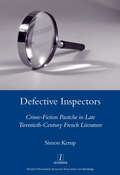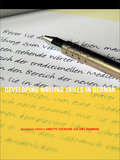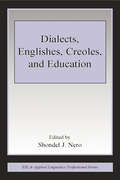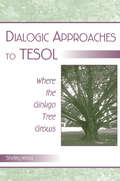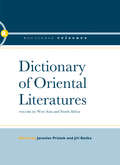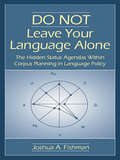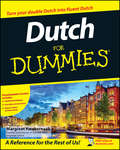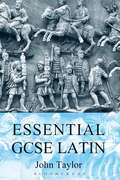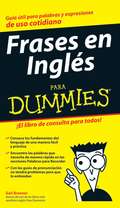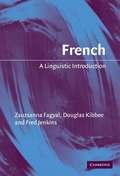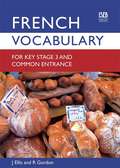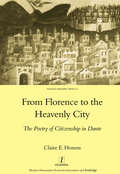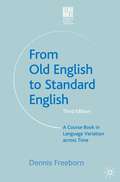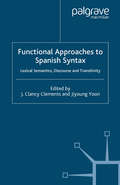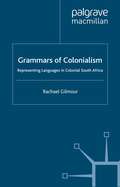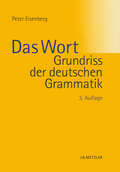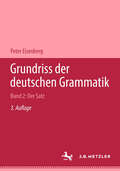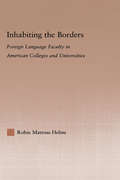- Table View
- List View
Defective Inspectors: Crime-fiction Pastiche In Late Twentieth-century French Literature
by Simon KempCrime fiction is a popular target for literary pastiche in France. From the nouveau roman and the Oulipo group to the current avant-garde, writers have seized on the genre to exploit it for their own ends, toying with its traditional plots and characters, and exploring its preoccupations with perception, reason and truth. In the first full-length study of the phenomenon, Simon Kemp's investigation centres on four major writers of the twentieth century, Alain Robbe-Grillet (b. 1922), Michel Butor (b. 1926), Georges Perec (193682) and Jean Echenoz (b. 1947). Out of their varied encounters with the genre, from deconstruction of the classic detective story to homage to the roman noir, Kemp elucidates the complex relationship between the pasticheur and his target, which demands an entirely new assessment of pastiche as a literary form.
Defective Inspectors: Crime-fiction Pastiche in Late Twentieth-century French Literature
by Simon KempCrime fiction is a popular target for literary pastiche in France. From the nouveau roman and the Oulipo group to the current avant-garde, writers have seized on the genre to exploit it for their own ends, toying with its traditional plots and characters, and exploring its preoccupations with perception, reason and truth. In the first full-length study of the phenomenon, Simon Kemp's investigation centres on four major writers of the twentieth century, Alain Robbe-Grillet (b. 1922), Michel Butor (b. 1926), Georges Perec (193682) and Jean Echenoz (b. 1947). Out of their varied encounters with the genre, from deconstruction of the classic detective story to homage to the roman noir, Kemp elucidates the complex relationship between the pasticheur and his target, which demands an entirely new assessment of pastiche as a literary form.
Developing Writing Skills in German
by Annette Duensing Uwe BaumannDeveloping Writing Skills in German, is a unique course designed to improve the reading and writing skills of intermediate students of German. Presenting a wide range of authentic written materials, the book aims to develop reading strategies and the ability to write texts of various types - essays, articles and reviews - while imparting an understanding of important aspects of German society. From the environment to consumerism, each chapter focuses on a different theme and concentrates on the advancement of particular skills; all the chapters conclude with a task appropriate to the skills focus of the section. Summary writing, note-taking, the use of mind-maps to collect ideas, and other strategies for successful writing in German are presented here. This course is suitable both for classroom use and independent study, with feedback and answer key supplied at the back of the book.
Developing Writing Skills in German
by Annette Duensing Uwe BaumannDeveloping Writing Skills in German, is a unique course designed to improve the reading and writing skills of intermediate students of German. Presenting a wide range of authentic written materials, the book aims to develop reading strategies and the ability to write texts of various types - essays, articles and reviews - while imparting an understanding of important aspects of German society. From the environment to consumerism, each chapter focuses on a different theme and concentrates on the advancement of particular skills; all the chapters conclude with a task appropriate to the skills focus of the section. Summary writing, note-taking, the use of mind-maps to collect ideas, and other strategies for successful writing in German are presented here. This course is suitable both for classroom use and independent study, with feedback and answer key supplied at the back of the book.
Dialects, Englishes, Creoles, and Education (ESL & Applied Linguistics Professional Series)
by Shondel J. NeroThis volume brings together a multiplicity of voices--both theoretical and practical--on the complex politics, challenges, and strategies of educating students--in North America and worldwide--who are speakers of diverse or nonstandard varieties of English, creoles, and hybrid varieties of English, such as African American Vernacular English, Caribbean Creole English, Tex Mex, West African Pidgin English, and Indian English, among others. The number of such students is increasing as a result of the spread of English, internal and global migration, and increased educational access. Dialects, Englishes, Creoles, and Education offers:*a sociohistorical perspective on language spread and variation;*analysis of related issues such as language attitudes, identities, and prescribed versus actual language use; and*practical suggestions for pedagogy.Pedagogical features: Key points at the beginning of each chapter help focus the reader and provide a framework for reading, writing, reflection, and discussion; chapter-end questions for discussion and reflective writing engage and challenge the ideas presented and encourage a range of approaches in dealing with language diversity. Collectively, the chapters in this volume invite educators, researchers, and students, across the fields of TESOL, applied linguistics, sociolinguistics, English, literacy, and language education, to begin to consider and adopt context-specific policies and practices that will improve the language development and academic performance of linguistically diverse students.
Dialects, Englishes, Creoles, and Education (ESL & Applied Linguistics Professional Series)
by Shondel J. NeroThis volume brings together a multiplicity of voices--both theoretical and practical--on the complex politics, challenges, and strategies of educating students--in North America and worldwide--who are speakers of diverse or nonstandard varieties of English, creoles, and hybrid varieties of English, such as African American Vernacular English, Caribbean Creole English, Tex Mex, West African Pidgin English, and Indian English, among others. The number of such students is increasing as a result of the spread of English, internal and global migration, and increased educational access. Dialects, Englishes, Creoles, and Education offers:*a sociohistorical perspective on language spread and variation;*analysis of related issues such as language attitudes, identities, and prescribed versus actual language use; and*practical suggestions for pedagogy.Pedagogical features: Key points at the beginning of each chapter help focus the reader and provide a framework for reading, writing, reflection, and discussion; chapter-end questions for discussion and reflective writing engage and challenge the ideas presented and encourage a range of approaches in dealing with language diversity. Collectively, the chapters in this volume invite educators, researchers, and students, across the fields of TESOL, applied linguistics, sociolinguistics, English, literacy, and language education, to begin to consider and adopt context-specific policies and practices that will improve the language development and academic performance of linguistically diverse students.
Dialogic Approaches to TESOL: Where the Ginkgo Tree Grows
by Shelley WongThis book locates dialogic pedagogy within the history of TESOL approaches and methods in which the communicative approach has been the dominant paradigm. Dialogic inquiry in the form of story telling, oral histories, and knowledge from the ground up and from the margins has much to offer the field. In dialogic approaches, the teacher and students learn in community and the students' home languages and cultures, their families and communities, are seen as resources.Dialogic Approaches to TESOL: Where the Ginkgo Tree Grows explores teacher research, feminist contributions to voice, social identity and dialogic pedagogy, and the role of teachers, students, families, and communities as advocates and change agents. After a brief history of TESOL methods and an introduction to dialogic pedagogy, four features of dialogic approaches to TESOL are identified and discussed: learning in community, problem-posing, learning by doing, and who does knowledge serve? The main text in each chapter considers a single topic related to the concept of dialogic pedagogy. Branching text leads to related discussions without losing the main point of the chapter. This structure allows readers to become well-rooted in each component of dialogic pedagogy and to "branch out" into deeper philosophic understandings as well as actual practices across a range of contexts.Dialogic Approaches to TESOL offers a place for dialogue and reflection on the prospects for transforming educational institutions to serve those who have historically been excluded and marginalized. It provides questions, frameworks, and resources for those who are just beginning in the field and for U.S.-based educators who want to bring critical multicultural and multilingual perspectives into language arts, reading and literacy education.
Dialogic Approaches to TESOL: Where the Ginkgo Tree Grows
by Shelley WongThis book locates dialogic pedagogy within the history of TESOL approaches and methods in which the communicative approach has been the dominant paradigm. Dialogic inquiry in the form of story telling, oral histories, and knowledge from the ground up and from the margins has much to offer the field. In dialogic approaches, the teacher and students learn in community and the students' home languages and cultures, their families and communities, are seen as resources.Dialogic Approaches to TESOL: Where the Ginkgo Tree Grows explores teacher research, feminist contributions to voice, social identity and dialogic pedagogy, and the role of teachers, students, families, and communities as advocates and change agents. After a brief history of TESOL methods and an introduction to dialogic pedagogy, four features of dialogic approaches to TESOL are identified and discussed: learning in community, problem-posing, learning by doing, and who does knowledge serve? The main text in each chapter considers a single topic related to the concept of dialogic pedagogy. Branching text leads to related discussions without losing the main point of the chapter. This structure allows readers to become well-rooted in each component of dialogic pedagogy and to "branch out" into deeper philosophic understandings as well as actual practices across a range of contexts.Dialogic Approaches to TESOL offers a place for dialogue and reflection on the prospects for transforming educational institutions to serve those who have historically been excluded and marginalized. It provides questions, frameworks, and resources for those who are just beginning in the field and for U.S.-based educators who want to bring critical multicultural and multilingual perspectives into language arts, reading and literacy education.
Dictionary of Oriental Literatures 3: West Asia and North Africa
by Jirí BeckaThe Dictionary of Oriental Literatures fills a long-felt gap in Western literature by presenting a concise summary, in three volumes and about 2000 articles, of practically all the literatures of Asia and North Africa. The first volume describes the Chinese, Tibetan, Japanese, Korean and Mongolian literatures; the second covers the area of South and South-East Asia, comprising, besides all literatures of India and Pakistan, those of Nepal, Bangladesh, Sri Lanka, Myanmar, Thailand, Cambodia, Vietnam, Indonesia, Malaysia and the Philippines; and the third is devoted to the numerous literatures of West Asia and North Africa. including on the one hand the literatures of the ancient Near East and Egypt, and on the other hand those of Central Asia and the Caucasus, of Turkey, Iran, Afghanistan and of the various Arab countries including Morocco, Tunisia and Algeria. The majority of entries give information about the life and work of the individual writers and poets of the classical, medieval and modern periods of the literatures included and also attempt to evaluate their writings from the historical and aesthetic point of view. The remaining articles describe literary terms, genres, forms, schools, movements etc. The Dictionary has been prepared by the Oriental Institute in Prague under the supervision of a Advisory Editorial Board of European and American scholars of international reputation and is unique in that it is the fruit of the collaboration of over 150 orientalists from many parts of the world. Contents include: Volume I East Asia: The Far East, including Chinese, Tibetan, Japanese, Korean and Mongolian literatures. Volume II South and South-East Asia: Ancient Indian, Assamese, Baluchi, Bengali, Gujarati, Hindi, Indian literature in English, Indo-Persian, Kannada, Kashmiri, Maithili, Malayalam, Marathi, Oriya, Panjabi, Pashto, Rajasthani, Sindhi, Tamil, Telugu and Urdu, Sinhalese, Nepali, Burmese, Thai, Cambodian, Malay and Indonesian, Javanese, Vietnamese and Philippines literatures. Volume III West Asia and North Africa: The Near East and Egypt, Central Asia and the Caucasus, Turkish, Persian, Afghan, Kurd and Arabic literatures, covering all the Arab states from Iraq in the East to Algeria in the West.
Dictionary of Oriental Literatures 3: West Asia and North Africa
by Jaroslav Průšek Jirí BeckaThe Dictionary of Oriental Literatures fills a long-felt gap in Western literature by presenting a concise summary, in three volumes and about 2000 articles, of practically all the literatures of Asia and North Africa. The first volume describes the Chinese, Tibetan, Japanese, Korean and Mongolian literatures; the second covers the area of South and South-East Asia, comprising, besides all literatures of India and Pakistan, those of Nepal, Bangladesh, Sri Lanka, Myanmar, Thailand, Cambodia, Vietnam, Indonesia, Malaysia and the Philippines; and the third is devoted to the numerous literatures of West Asia and North Africa. including on the one hand the literatures of the ancient Near East and Egypt, and on the other hand those of Central Asia and the Caucasus, of Turkey, Iran, Afghanistan and of the various Arab countries including Morocco, Tunisia and Algeria. The majority of entries give information about the life and work of the individual writers and poets of the classical, medieval and modern periods of the literatures included and also attempt to evaluate their writings from the historical and aesthetic point of view. The remaining articles describe literary terms, genres, forms, schools, movements etc. The Dictionary has been prepared by the Oriental Institute in Prague under the supervision of a Advisory Editorial Board of European and American scholars of international reputation and is unique in that it is the fruit of the collaboration of over 150 orientalists from many parts of the world. Contents include: Volume I East Asia: The Far East, including Chinese, Tibetan, Japanese, Korean and Mongolian literatures. Volume II South and South-East Asia: Ancient Indian, Assamese, Baluchi, Bengali, Gujarati, Hindi, Indian literature in English, Indo-Persian, Kannada, Kashmiri, Maithili, Malayalam, Marathi, Oriya, Panjabi, Pashto, Rajasthani, Sindhi, Tamil, Telugu and Urdu, Sinhalese, Nepali, Burmese, Thai, Cambodian, Malay and Indonesian, Javanese, Vietnamese and Philippines literatures. Volume III West Asia and North Africa: The Near East and Egypt, Central Asia and the Caucasus, Turkish, Persian, Afghan, Kurd and Arabic literatures, covering all the Arab states from Iraq in the East to Algeria in the West.
DO NOT Leave Your Language Alone: The Hidden Status Agendas Within Corpus Planning in Language Policy
by Joshua A. FishmanThis book, focused on corpus planning in language policy, provides a broad, integrative framework and also discusses multiple languages in detail. It provides readers with great familiarity with a wide range of language cases and at the same time gives them the theoretical tools and analysis to see how they inter-relate.The novelty of this volume i
DO NOT Leave Your Language Alone: The Hidden Status Agendas Within Corpus Planning in Language Policy
by Joshua A. FishmanThis book, focused on corpus planning in language policy, provides a broad, integrative framework and also discusses multiple languages in detail. It provides readers with great familiarity with a wide range of language cases and at the same time gives them the theoretical tools and analysis to see how they inter-relate.The novelty of this volume i
Dutch For Dummies
by Margreet KwakernaakDutch is spoken by 23 million people, mainly in the Netherlands and Belgium, and is an official EU language. For English speakers, written Dutch can be fairly straightforward to pick up, although the pronunciation can be more of a challenge. This simple guidebook and audio CD covers Dutch grammar, pronunciation and everyday phrases, making this vibrant language more accessible to English speakers – whether you’re just visiting or planning to stay on a long-term basis. Dutch For Dummies is the essential guide for everyone from students and holidaymakers, to those wanting to speak Dutch for business purposes. From numbers and vocabulary to greetings, popular expressions and proper etiquette, this clear, easy-to-follow guide will have you speaking Dutch like a native in no time. Dutch For Dummies includes: Audio CD to assist learning Introductory grammar and vocabulary Meeting and getting to know people Dining out, shopping, leisure time and the workplace Dealing with emergencies Tips on how to pick up Dutch quickly Note: CD files are available to download when buying the eBook version
Essential GCSE Latin (PDF)
by John TaylorOCR is the only board in that offers a GCSE in Latin language. This title offers summary of the linguistic requirements for the OCR Examination Board specification, aimed mainly at pupils in their GCSE year. It contains examples and practice sentences (600) on each point, as well as cross-referencing.
Frases en Inglés Para Dummies
by Gail BrennerUna guía práctica para las personas de habla hispana que desean aprender inglés Escrito para millones de americanos que hablan español y quieren mejorar o aprender inglés. Ingles Frases Para Dummies es un recurso básico para mejorar su comunicación en el mundo de habla inglesa. Escrito por Gail Brenner, un escritor veterano, editor, y traductor con más de treinta años de experiencia, este libro le ayudara a entender lo básico para poder hablar inglés con confianza. Escrito por un experto lingüístico y traductor Ofrece frases comunes en inglés para ayudar a navegar el idioma más fácilmente Incluye ejemplos útiles de que decir en caso de emergencia Con Ingles Frases para Dummies como sú guía, usted puede mejorar su inglés y afinar sus habilidades con el idioma. ENGLISH DESCRIPTION A handy guide for Spanish speakers who wish to learn English Written for the millions of Americans who speak Spanish and want to improve or learn English, Ingles Frases Para Dummies is a basic resource for improving your communication in an English speaking world. Written by Gail Brenner, a veteran writer, editor, and translator with more than thirty years of experience, this book will help you understand the basics so you can speak English with confidence. Written by a leading linguistic expert and translator Offers common English phrases and sayings to help you navigate the language easily Includes helpful examples of what to say in case of emergency With Ingles Frases Para Dummies as your guide, you can learn to improve your English and fine tune your language skills.
French: A Linguistic Introduction (PDF)
by Zsuzsanna Fagyal Frederic Jenkins Douglas A. KibbeeFrench is used on every continent, spoken not only in France but also in Belgium, Switzerland, North America, the Caribbean, Polynesia and Africa. This is a comprehensive and accessible guide to the structure of French, suitable for those with little prior knowledge of linguistics or of the French Language. It clearly introduces the language's history, phonetics (pronunciation), phonology (sound system), morpho-syntax (how words and sentences are formed), pragmatics (how speakers express meaning), and lexicology (the study of word composition and derivation) - with each chapter showing how these aspects are subject to regional and social variation. English translations are provided for all examples, and the book contains an extensive bilingual glossary of linguistic terms, and numerous exercises and essay questions in every chapter. French: A Linguistic Introduction will be welcomed by advanced language learners, and by linguists studying the structure of this important language.
French Vocabulary for Key Stage 3 and Common Entrance (PDF)
by John Ellis Richard GordonCovers various topics in the 13+ French syllabus with nouns, verbs, adjectives and other words. This book includes a selection of short dictees at the end of each topic.
From Florence to the Heavenly City: The Poetry of Citizenship in Dante
by ClaireE. HonessDante's political thought has long constituted a major area of interest for Dante studies, yet the poet's political views have traditionally been considered a self-contained area of study and viewed in isolation from the poet's other concerns. Consequently, the symbolic and poetic values which Dante attaches to political structures have been largely ignored or marginalised by Dante criticism. This omission is addressed here by Claire Honess, whose study of Dante's poetry of citizenship focuses on more fundamental issues, such as the relationship between the individual and the community, the question of what it means to be a citizen, and above all the way in which notions of cities and citizenship enter the imagery and structure of the Commedia.
From Florence to the Heavenly City: The Poetry of Citizenship in Dante
by ClaireE. HonessDante's political thought has long constituted a major area of interest for Dante studies, yet the poet's political views have traditionally been considered a self-contained area of study and viewed in isolation from the poet's other concerns. Consequently, the symbolic and poetic values which Dante attaches to political structures have been largely ignored or marginalised by Dante criticism. This omission is addressed here by Claire Honess, whose study of Dante's poetry of citizenship focuses on more fundamental issues, such as the relationship between the individual and the community, the question of what it means to be a citizen, and above all the way in which notions of cities and citizenship enter the imagery and structure of the Commedia.
From Old English To Standard English: A Course Book In Language Variation Across Time (PDF)
by Dennis FreebornThis practical course book explores the development of the language from Old English to the establishment of Standard English. This third edition has been expanded to provide further background information, with a supplementary website and new sections to outline the development of writing hands and provide a brief introduction to palaeography.
Functional Approaches to Spanish Syntax: Lexical Semantics, Discourse and Transitivity
by J. Clements J. YoonThe first usage-based approach of its kind, this volume contains twelve studies on key issues in Spanish syntax: word order, arguments, grammatical-relation marking, inalienable possession, ser and estar , adjective placement, small clauses and causatives. The studies are approached within a broad functionalist perspective. The studies strengthen the view that components of grammar intricately interact and that a usage-based approach to analyzing them offers new and insightful perspectives on some stubborn problems.
Grammars of Colonialism: Representing Languages in Colonial South Africa
by Rachael GilmourThe study of languages was crucial to colonial power in 18th and 19th-century South Africa. This important book examines representations of the South African Bantu languages Xhosa and Zulu, revealing the ways in which colonial linguistics contributed to both the making of the colonial order and to instabilities at the heart of the project.
Grundriss der deutschen Grammatik: Band 1: Das Wort
by Peter EisenbergWort und Satz gelten als kommunikative Säulen einer Sprache. Der 'Grundriss der deutschen Grammatik' greift diese Zweigliederung auf. Die Teilbände 'Das Wort' und 'Der Satz' ergänzen sich und sind zugleich unabhängig voneinander einsetzbar. Präzise und gut verständlich wird die gesamte Grammatik ausgebreitet. Rund 200 Aufgaben und Lösungen führen differenzierte Analysewege vor. Ein glänzendes Lehrbuch, auch für das Selbststudium geeignet. Der Teilband 'Das Wort' fächert die Wortgrammatik des Deutschen in ihre großen Themenfelder auf: Phonetik und Phonologie, Morphologie und Orthografie.
Grundriss der deutschen Grammatik: Band 2: Der Satz
by Peter EisenbergWort und Satz gelten als kommunikative Säulen einer Sprache. Der 'Grundriss der deutschen Grammatik' greift diese Zweigliederung auf. Die Teilbände 'Das Wort' und 'Der Satz' ergänzen sich und sind zugleich unabhängig voneinander einsetzbar. Präzise und gut verständlich wird die gesamte Grammatik ausgebreitet. Rund 200 Aufgaben und Lösungen führen differenzierte Analysewege vor. Ein glänzendes Lehrbuch, auch für das Selbststudium geeignet. Der Teilband 'Der Satz' führt systematisch in die Formen- und Satzlehre des Deutschen ein. In übersichtliche Lerneinheiten gegliedert, lässt das Lehrbuch keinen Aspekt außer Acht.
Inhabiting the Borders: Foreign Language Faculty in American Colleges and Universities (Studies in Higher Education)
by Robin Matross HelmsThis book focuses on the experience of foreign language faculty in American colleges and universities, the challenges they face, and ways that academia can better support language faculty, and marginalized faculty in other fields, in their important work.
